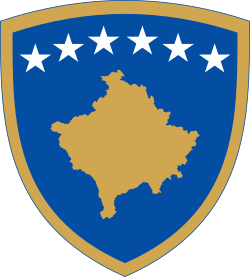Gjilan
| Gjilan | |
|---|---|
| Municipality and town | |
| Albanian: Gjilan / Gjilani Serbian: Gnjilane / Гњилане | |
|
Mosque in Gjilan | |
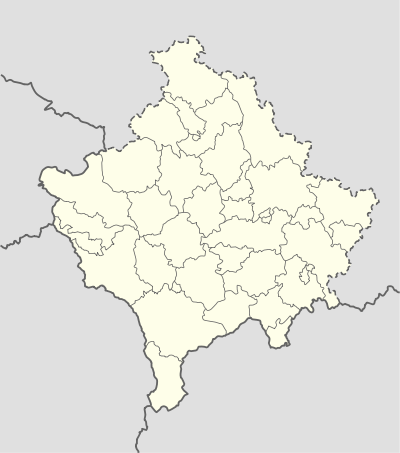 Gjilan Location in Kosovo | |
| Coordinates: 42°27′53″N 21°28′1″E / 42.46472°N 21.46694°E | |
| Country | Kosovo[lower-alpha 1] |
| District | District of Gjilan |
| Government | |
| • Mayor | Lutfi Haziri (LDK) |
| Area | |
| • Municipality and town | 392 km2 (151 sq mi) |
| • Metro | 13.302 km2 (5.136 sq mi) |
| Elevation | 508 m (1,667 ft) |
| Population (2014) | |
| • Municipality and town | 87,835 |
| • Density | 220/km2 (580/sq mi) |
| • Metro | 52,000 |
| • Metro density | 3,900/km2 (10,000/sq mi) |
| Time zone | CET (UTC+1) |
| • Summer (DST) | CEST (UTC+2) |
| Postal code | 60000 |
| Area code(s) | +381 280 |
| Website | Municipality of Gjilan |
Gjilan (Albanian) or Gnjilane (Serbian: Гњилане) is a city and municipality in eastern Kosovo.[lower-alpha 1] It is the administrative center of the District of Gjilan. It is famous for having recorded the lowest temperature in Kosovo with −32.5 °C (−26.5 °F) on 25 January 1963.[1]
Geography
Gjilan is located in the southern Binačka Morava river basin (Binačko Pomoravlje).
Name
Ottoman chronicler Evliya Çelebi mentions Morava as a settlement of the Sanjak of Vučitrn. Çelebi writes that: "The seventeen day journey from Constantinople (Istanbul) to pass through Vranje, Novo Brdo, Krivareka (Egridere) and Morava (Gjilan). The etymology of Gjilan is disputed. Albanian sources claim that the town (initially a village) obtained its name from Bahti Beg Gjinolli of Gjinaj clan that ruled the region of Vučitrn (Llapi and Drenica), and populated this area in the 18th century (around 1750). However, there is no definite evidence to support that claim, and in fact no one can confirm as to who the first true inhabitants were, or when they first settled there. On the other hand, Serbian sources claim that the origin of the town name is in the Serbian word gnjio (putrid, rotten).[2]
History
Middle Ages and Ottoman period
In 1342, a place called Morava was visited by Serbian King Stefan Dušan (later Emperor, r. 1331-1355).[3] A fort was built nearby in the 14th century. Gornja Morava was known as simply Morava under Ottoman rule, and it extended west of the Upper Žegra-Budriga-Cernica line, thus Gjilan stayed in the oblast (province) of Topolnica, which provincial seat was Novo Brdo.[4] In the 1455 defter (Ottoman tax registry), Gjilan was inhabited by Serbs, and the priest Božidar served the town.[5] There were 41 households. Haji Kalfa (first half of the 17th century) mentions Morava being 17 days from Constantinople.[3] Gornja Morava and Izmornik were organized into the Sanjak of Vučitrn up until the 18th century.[6] Gjilan became a kadiluk around 1780, and 20–25 years later a large village.[7]
Modern history
In 1915, in and around the city, the Serbian army made a futile stand against the 1st Army of Bulgaria, during the World War I Battle of Kosovo. That battle resulted in the defeat of the Serbian military, and the occupation by the forces allied with the then German Empire, though the territory was finally liberated by the Serbs in 1918.
In World War II there was a significant amount of activity in and around Gjilan by the Partisans fighting against Nazi Germany and her allies. Monuments to these actions can still be found today, one of which is located in the middle of the village of Koretište.
In 1999, Camp Monteith was established outside the city as a base of operations for KFOR during Operation Joint Guardian, on the site of a destroyed Serbian military base which is handed over to Kosovo Protection Corps in 2007 after U.S. Military downsized their troops. Gjilan has also served as the regional headquarters of the UNMIK International Police task force from 1999.
In between 23 and 27 November 1999, during the Gnjilane massacre, Gnjilane was the scene of the killing of 104 Serb civilians by the Kosovo Liberation Army (UCK) paramilitary troops and Albanian extremists in November 1999, during the Kosovo War.[8]
Population

In March 2011, the Gjilan municipality was estimated to have over 90,015 residents.[9] The vast majority of the population is Albanian, followed by Serbs, and a small number of minorities. The population density was 229.7 km2 (595 sq mi).
Languages
Albanian, Serbian and Turkish languages are official languages in the municipality.[10]
| Ethnic composition | |||||||||||||
| Year/Population | Albanians | % | Serbs | % | Roma | % | Others | % | Total | ||||
|---|---|---|---|---|---|---|---|---|---|---|---|---|---|
| 1953 | 24,797 | 50.87 | 19,196 | 39.32 | 48,748 | ||||||||
| 1961 | 29,942 | 57.12 | 18,297 | 34.91 | 735 | 1.50 | 52,415 | ||||||
| 1971 | 43,754 | 64.45 | 20,237 | 29.81 | 1,824 | 2.69 | 67,893 | ||||||
| 1981 | 59,764 | 71.08 | 19,212 | 22.85 | 3,347 | 3.98 | 1,762 | 2.1 | 84,085 | ||||
| 1991 | 79,357 | 76.54 | 19,370 | 18.68 | 3,477 | 3.4 | 1,471 | 1.4 | 103,675 | ||||
| 1998 | 94,218 | 79.4 | 19,481 | 16.4 | 3,568 | 3 | 1,387 | 1.2 | 118,654 | ||||
| 2011 | 87,814 | 97,45 | 624 | 0,7 | 361 | 0,4 | 1,379 | 1,52 | 90,178 | ||||
| Source: Yugoslav Population Censuses for data through 1991,and Kosovo 2011 census. | |||||||||||||
In the municipality according to the 2011 census there are 978 Turks or 1% of the municipality population. The number of Serbs has decreased due to boycott[11] and the creation of the Serb-majority municipality of Parteš.
Education
Education in Gjilan includes primary, secondary education, and a public university. Currently there are 23,608 Albanian students and 881 minority students enrolled in educational institutions around Gjilan.
Economy
There are 3,700 registered private businesses in the municipality employing 7,900 people. Before 1999, Gjilan was an important industrial centre in Kosovo. Still in operation are the radiator factory and tobacco factory, which has been recently privatized. The new city business incubator, supported by the European Agency for Reconstruction, was inaugurated in summer 2007.
Culture
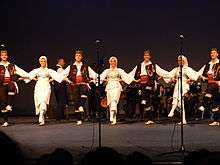
Flaka e Janarit
Flaka e Janarit is a cultural event that starts on January 11 in Gjilan, Kosovo with symbolic opening of the flame, to keep up with various cultural activities to 31 January of each year. It gathers thousands of artists and art lovers from all the Albanian territories, who for three consecutive weeks transform the city into a cultural metropolis. The nation's martyrs are honored through values of art by this event, which began before the 10th anniversary of the assassination of writer, activist and patriot Jusuf Gërvalla, along with Kadri Zeka and Bardhosh Gërvalla. It was exactly the 10th anniversary without these three martyrs of freedom and from coincidence of these murders in a same date on 11 January, this event got this name "Flaka e Janarit". Moreover, this month has "eaten" lots of devout patriots.[12]
Features
Gjilan is now the administrative center of the District of Gjilan of Kosovo. Since February 15, 2003, it is the headquarters of the Local Democracy Agency in Kosovo of the Council of Europe.
Sports
Gjilan is home to the basketball club Drita Gjilan, the football clubs KF Gjilani and KF Drita and volleyball club KV Drita, male and female- the most successful club in Gjilan's history.
Gallery
-

Gjilan old city center 1913
-
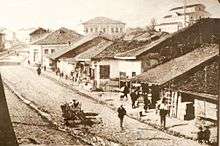
Gjilani 1925
-

Haus Zekirja Abdullahu in Gjilan
-

Monastery of St. Nicholas, Straza Gjilan
-

-

City of theater in Gjilan
-

Muzices schoole
Notable people
- Zoran Antić (b. 1975), Serbian footballer
- Faton Bislimi (b. 1983), Kosovan author
- Nijazi Ramadani (b. 1964), Kosovan poetry writer
- Albert Bunjaku (b. 1983), Swiss footballer
- Daut Dauti (b. 1960) Kosovan author
- Dragan Dimić, Serbian footballer
- Bajram Haliti (b. 1955), Romani writer
- Shpëtim Hasani (b. 1982), Kosovan footballer
- Lutfi Haziri (b. 1969), Kosovan politician
- Genta Ismajli (b. 1985), Kosovan singer
- Ismet Munishi (b. 1974), Kosovan footballer
- Aljmir Murati (b. 1985), Swiss footballer
- Zenun Pajaziti (b. 1966), Kosovan politician
- Xherdan Shaqiri (b. 1991), Swiss footballer
- Jahi Jahiu, (b. 1959), Kosovan artist
- Mira Stupica (b. 1923), Serbian actress
- Goran Svilanović (b. 1963), Serbian politician
- Faton Toski (b. 1987), German footballer
- Agim Ramadani (b. 1963), KLA commander
- Abdullah Tahiri (b. 1956), KLA commander
International relations
Twin towns – Sister cities
Gjilan is twinned with:
Annotations
- 1 2 Kosovo is the subject of a territorial dispute between the Republic of Kosovo and the Republic of Serbia. The Republic of Kosovo unilaterally declared independence on 17 February 2008, but Serbia continues to claim it as part of its own sovereign territory. The two governments began to normalise relations in 2013, as part of the Brussels Agreement. Kosovo has received recognition as an independent state from 110 out of 193 United Nations member states.
References
- ↑ in Gnjilane - AccuWeather Forecast for Gjilan Kosovo
- ↑ http://kk.rks-gov.net/gjilan/City-guide/History.aspx
- 1 2 Kostić 1922, p. 126
ГЊИЛАНЕ. ИЛИ. ГИЉАНЕ. У 14. веку помиње се неко место Морава, где се 1342. год бакио краљ Душан. Хаџи Калфа (прва половина 17. века) помиње неко место Мораву, на 17 дана од Цариграда. Јањева, Новог Брда и Кача- ...
- ↑ Urošević/Macura 1987, p. 10
Горња Морава се под турском управом звала само Мора- ва, а протезала се западно од линије с. Жегра — Будрига — Церница, тако да је Гњилане остајало у области Топонице, чије је обласно средиште било Ново Брдо.
- ↑ Kalezić 2002, p. 448
Из турског дефтера (1455) види се да је насељено Србима и да је у њему служио свештеник Божидар. Старо Гњилане налазило се у Петиковиди (Петковици) предграђу данашњег насеља које је подиг- нуто на месту
- ↑ Urošević/Macura 1987, p. 11
- ↑ Cvijić 1930, p. 38
Гњилане је дакле могло постати тек после овог кадије, око 1780 године, тако да је после 20 — 25 година, на крају 18 века, могло бити велико село — варошица. При доласку Џинића у новобрдски
- ↑ News – Ex-KLAs sent to prison for 101 years. B92. Retrieved on 2011-04-30.
- ↑ "Gjilan/Gjilan" (PDF). Organization for Security and Cooperation in Europe. 2008. Retrieved 2008-11-10.
- ↑ OSCE Implementation of the Law on the Use of Languages by Kosovo Municipalities
- ↑ "ECMI: Minority figures in Kosovo census to be used with reservations". ECMI.
- ↑ Rrustemi, Sabit (2001). Cultural literary magazine "Agmia". 5: Pg.85–86. Missing or empty
|title=(help)
Sources
- А. Урошевић: Гњилане. — Гласник Географског друштва, св. ХУП. Београд, 1931
- А. Урошевић: Горња Морава и Изморник., Насеља и порекло становништва, књ. 28, Београд 1935
External links
| | |||||||||
|---|---|---|---|---|---|---|---|---|---|
| Rank | Name | Districts | Pop. | Rank | Name | Districts | Pop. | ||
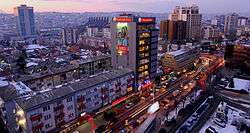 Pristina Prizren |
1 | Pristina | Pristina | 210,722 | 11 | Glogovac (Drenas) | Pristina | 61,522 |  Ferizaj (Uroševac)  Peć |
| 2 | Prizren | Prizren | 186,860 | 12 | Lipljan | Pristina | 60,517 | ||
| 3 | Ferizaj (Uroševac) | Ferizaj (Uroševac) | 114,087 | 13 | Orahovac | Gjakova | 59,021 | ||
| 4 | Peć | Peć | 100,081 | 14 | Mališevo | Prizren | 58,198 | ||
| 5 | Gjakova | Gjakova | 98,240 | 15 | Skenderaj (Srbica) | Mitrovica | 52,951 | ||
| 6 | Gjilan | Gjilan | 93,291 | 16 | Vitina | Gjilan | 48,861 | ||
| 7 | Podujevo | Pristina | 91,642 | 17 | Deçan | Peć | 41,523 | ||
| 8 | Mitrovica | Mitrovica | 85,910 | 18 | Istok | Peć | 40,935 | ||
| 9 | Vučitrn | Mitrovica | 72,780 | 19 | Klina | Peć | 40,675 | ||
| 10 | Suva Reka | Prizren | 62,913 | 20 | Kosovo Polje (Fushë Kosova) | Pristina | 38,265 | ||
Coordinates: 42°28′N 21°29′E / 42.47°N 21.48°E
| Wikimedia Commons has media related to Gjilan. |

